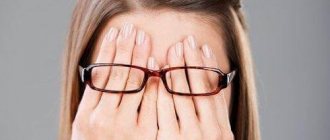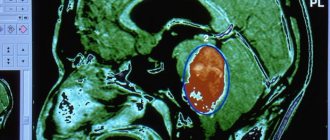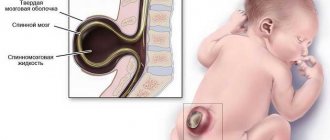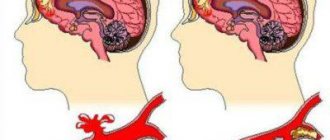Psychosis: symptoms of the disorder
Due to the existing diversity of psychotic disorders, it is impossible to describe in one publication all the symptoms demonstrated in psychosis. It can be argued that the manifestations and signs of psychosis are limitless, just as the human psyche is multifaceted and unique. However, symptoms that may indicate the onset and development of a psychotic disorder have been studied and described.
You should know that the first symptoms of the disease can be detected in a person long before the onset of psychosis. Such conditioned signals include any changes occurring in a person’s mental activity that arise spontaneously and unexpectedly in the absence of adequate reasons. Precursors of psychosis include:
- excessive nervousness, causeless irritability of a person;
- sudden and sharp change in mood, its fluctuations from a state of deep sadness to euphoria;
- psychomotor agitation and motor restlessness;
- significant slowness of reactions, inhibition of the subject;
- the appearance of problems with sleep;
- sudden change in eating behavior;
- a significant decline in performance, inability to perform usual professional duties;
- the emergence of irrational fears and illogical anxiety;
- sudden change in habits;
- voluntary isolation of a person from society;
- groundless change of interests and hobbies.
All symptoms of psychosis are divided into two conventional categories: positive signs and negative signs.
Positive symptoms of psychosis
include :
- Verbal, visual, olfactory, gustatory, vestibular, visceral, tactile hallucinations of simple and complex forms. Most often, the individual hears “voices” coming from outside. Bright and distinct sounds may come from the patient's head. The perceived message from the “voices” may have a neutral color, but most often the patient is threatened, humiliated or accused, or ordered to perform some action. When experiencing verbal hallucinations, the subject may talk to himself. A person may suddenly become wary and begin to listen carefully to something. He may start crying a lot or laughing for no reason.
- Delusional inclusions are diverse ideas, reasoning, conclusions, conclusions that do not reflect the actual picture of reality and cannot be corrected with the help of beliefs and explanations. The most common type is delusion of persecution, when a person is sure that he is being watched, intrigues are being woven against him, there are conspiracies to injure or kill him. Delusions of influence are also widespread - a phenomenon when a patient is convinced that he is being influenced by some otherworldly forces or other structures, for example: special services, using classified equipment.
- A common symptom of psychosis is delusion of harm , characterized by a person’s conviction that they want to harm him. Symptoms of psychosis also include hypochondriacal delusion - a phenomenon when the subject is sure that he is sick with some kind of incurable disease. Another symptom of psychosis is no less common - delusions of jealousy, when an individual is sure that his other half is cheating on him. Other delusional ideas may also occur, for example: delusions of grandeur.
- Movement disorders of akinetic-rigid types and hyperkinetic forms, manifested in diametrically opposite phenomena - in the form of stupor (retardation) or motor excitation. In the first case, the individual looks inactive, his body takes on a static and unnatural position, he seems to freeze in one position. A person can remain motionless for hours, staring at one point. He does not respond to requests addressed to him and stops giving answers to questions. In the case of psychomotor agitation, the subject cannot remain without movement. His actions are chaotic and inconsistent, impulsive and unmotivated. His speech is verbose and illogical. There is a noticeable increase in gesticulation, the person vigorously waves his arms and grimaces.
- Mood disorders are mood instability in the form of depressive episodes and manic states. Symptoms of a depressive nature in psychosis are a melancholy mood, depression, a pessimistic outlook on life, the emergence of ideas of self-blame, and suicidal behavior. Symptoms of a manic state are excessively elevated mood, a tireless thirst for activity, overestimation of one’s own capabilities, disinhibition of drives and impulses.
Negative symptoms of psychosis
Negative signs of psychotic disorders include such phenomena that are characterized by a global change in the character and personal qualities of a person, the loss from the mental sphere of a huge part of the processes that were previously inherent in it. Negative symptoms of psychosis are:
- decline in human energy potential;
- reduction and subsequent complete disappearance of desires;
- lack of motivation, motivation, aspirations;
- the emergence and increase in dullness of the emotional response;
- social isolation of a person, voluntary isolation from society, reluctance to communicate in the human community;
- the disappearance of moral and ethical standards, the appearance of rudeness, vulgarity, aggressiveness;
- impoverishment of speech and thinking;
- behavior that is dangerous for the patient and others;
- rigidity, emptiness of thinking, lack of focus;
- loss of work skills and ability to self-care.
It is worth pointing out that mentally ill people cannot eliminate the symptoms of psychosis through willpower or coercion. Therefore, the understanding and support of loved ones is extremely important for them; consultation with a doctor and subsequent treatment are vital.
Read also…. What colors suit brown-haired women?
Classification of mental illnesses
According to etiology (origin), all mental illnesses can be divided into two groups:
- Endogenous - the causes of the disease in these cases are internal factors; This includes genetic diseases and diseases with a hereditary predisposition.
- Exogenous - the causative factors of these diseases are poisons, alcohol, traumatic brain injuries, radiation, infections, stressful situations, and psychological trauma. A type of exogenous diseases are psychogenic diseases that arise as a result of emotional stress, or may be associated with social or family problems.
The following types of mental disorders are distinguished:
- Phobias are mental disorders associated with fear. This group includes obsessive-compulsive disorders, stress and panic disorders, and generalized fear. In addition to generalized fear, there are diseases characterized by fear of specific phenomena or objects: animals, heights, travel, being in open areas of space or, conversely, fear of getting into a confined space.
- Depression . It becomes a chronic condition infrequently, more often it occurs once.
- Schizophrenia . One of the most common mental illnesses. Patients often prefer self-isolation from society, withdrawal into their personal experiences; suffer from disturbances of perception and thinking. Behavioral reactions include emotional dryness and apathy. Patients are characterized by detachment of thoughts, they feel that their thoughts and experiences were created by someone else.
- Manic-depressive psychosis (bipolar affective disorder). The condition is characterized by a sharp change in symptoms of mania, agitation, and depressive episodes. Between “cycles” consisting of mania and depression, “bright” intervals—remissions—are also possible.
- Unipolar affective illness.
- Dissociative mental disorder . Manifested by loss of personal identity; the patient seems to feel a “division” of his personality into two or more, which are perceived by him as separate subjects.
- Conditions associated with eating disorders - bulimia and anorexia - can also lead to serious mental disorders.
- Dependence on psychotropic substances.
- Alcohol disease . This group includes non-hallucinatory alcoholic dementia (not accompanied by symptoms of delirium), alcoholic psychosis, alcoholic delirium of jealousy, alcoholic hallucinosis, delirium tremens (alcohol withdrawal delirium).
- Sleep disorders . For example, insomnia of non-organic origin, which is a symptom of anxiety or affective disorders, and not of somatic pathologies.
- Degenerative diseases of the central nervous system . A classic example is Alzheimer's disease, when, as a result of primary degeneration in presenile or early senile age, steadily progressive dementia develops; morphological substrate - atrophy of the cerebral cortex. Pick's disease is a presenile dementia of a degenerative nature, accompanied by euphoria, extrapyramidal symptoms, disorders of language, memory, and intellect.
- Personality disorders .
Treatment of psychological diseases
It is quite difficult to treat human psychological diseases, but it is fully possible and effective. With such treatment, it is very important to determine the names of psychological diseases so that you can know with confidence what and for what to treat the patient.
Basically, all treatment involves a detailed study of the main psychosomatic symptoms. All mental illnesses and disorders are treated in psychological clinics by experienced specialists and safe medications for patients.
The probability of recovery of patients in our time is very high, but we should not put off the treatment of mental disorders for a long time. If there are psychological prerequisites for illness, immediate contact with a psychiatrist is the best option in this case!
Differences in the meaning of the term (depending on context)[ | ]
In jurisprudence[ | ]
In jurisprudence, mental disorder is defined as a more precise term introduced into the Criminal Code of the Russian Federation instead of the outdated concept of mental illness
;
includes temporary mental disorder, chronic mental disorder (disease), dementia, as well as other painful conditions (Article 21 of the Criminal Code of the Russian Federation). The presence of a mental disorder is a medical criterion, which, along with the legal one (the inability to realize the meaning of one’s actions or control them), determines the state of insanity in a person [ source not specified 3552 days
].
Under chronic mental disorder
jurisprudence understands a long-term mental disorder, which can, however, occur in attacks (that is, with an improvement or deterioration of the mental state), but leave behind a persistent mental defect.
Such mental illnesses include: schizophrenia, epilepsy, progressive paralysis, paranoia, bipolar disorder and other mental disorders [ source not specified 3552 days
].
Under temporary mental disorder
jurisprudence understands mental illnesses that last a relatively short time and end with recovery.
These include: pathological intoxication (delirium tremens), reactive symptomatic states, that is, mental disorders caused by severe mental shocks and experiences [ source not specified 3552 days
].
In psychiatry and psychopathology[ | ]
Painting by A. Gautier, depicting people with the most common mental disorders in the 19th century, in the gardens of the Salpetriere: dementia, megalomania, acute mania, melancholia, oligophrenia, hallucinations, erotomania and progressive paralysis.
In psychiatry and psychopathology, they start from ICD-10, and understand a term that enumerates a clinically defined group of symptoms or behavioral signs that typically cause distress and interfere with personal functioning[12].
We can distinguish: organic mental disorders (that is, caused by organic disorders), personality disorders, behavioral disorders, emotional (affective) disorders, disorders associated (caused) by the use of psychoactive substances, post-traumatic stress disorder and others. Some of these groups may overlap.
In clinical psychology and pathopsychology[ | ]
In pathopsychology (a branch of clinical psychology), when systematizing mental disorders, first of all, they take into account how the flow (structure) of the mental processes themselves, certain components of brain activity, its links and factors, the loss of which causes the formation of symptoms observed in the clinic [13 ].
The main method of differential diagnosis in pathopsychology is a pathopsychological experiment, in the diagnostic conclusions of which the pathopsychologist can operate on a set of pathopsychological register syndromes.
In psychology[ | ]
Psychology in general uses this term to describe any mental state other than healthy. Accordingly, the criteria for the presence of a mental disorder in this broad sense are the criteria inverse to the criteria for mental health, that is, any of the following:
- violation of the sense of continuity, constancy and identity of one’s physical and mental “”;
- lack of a sense of constancy and identity of experiences in similar situations;
- non-criticism towards oneself and one’s own mental production (activity) and its results;
- inconsistency of mental reactions (adequacy) with the strength and frequency of environmental influences, social circumstances and situations;
- inability to self-manage behavior in accordance with social norms, rules, laws;
- inability to plan one’s own life activities and implement these plans;
- inability to change behavior depending on changing life situations and circumstances.










